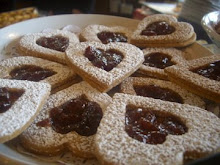
New Years is my most favorite holiday to eat! My grandma was born and raised in Japan, so she always takes great pride and effort to plan our New Years feast. Many of the dishes are prepared with precise techniques and require patience and a delicate hand. The time and effort invested into the preparations make each of the dishes all the more special. Each of the dishes are part of the traditional Japanese New Years celebration, with the significance of good luck for the new year. Grandma begins planning before Christmas, and preparations begin the day after Christmas. This year she made the traditional mochi ozoni (mochi soup), maki sushi, kuromame (black beans), kazunoko (fish roe), araimo (taro), tamagoyaki (grilled sweet egg), koyadofu (dried-frozen tofu in broth), boiled ebi (shrimp), and kanten (gelatin dessert).

The kuromame are sweet black beans that are simmered in a sauce made of sugar, shoyu, and salt. These beans are simmered for over four hours using a special technique. In order to remove the bitterness from the beans, and to keep the broth clear (rather than cloudy), the starchy scum that forms at the surface needs to be scraped off during several intervals of the cooking process. While the beans cook, an "otoshi buta" or wooden cover is placed on top in order to ensure that the beans remain submerged in the liquid. Additionally, in order to make the beans shiny, a bag sealed with special types of nails (tetsu no kugi) are placed in the liquid. It is said that you need to eat one bean for each year depending on how old you are in order to have good luck in the new year. I always have way more than I need to just because its so delicious! I only get to eat these beans once a year because of the meticulous process involved in the preparation.

The kazunoko is also prepared days in advanced. Because the fish eggs are so salty when you first get them, they are soaked several days prior to new years, alternating between fresh water and salt water. Once they are at the right level of saltiness they are soaked in a broth made of shoyu, sake, dashi (soup stock) and sugar. These crunchy fish eggs have an acquired taste and texture. I just love it and I look forward to eating this each year!!

Tamagoyaki is a rolled omelet made from a sweet egg mixture. The egg mixture includes eggs, sugar, dashi (soup stock), sake, and salt. A thin layer of egg is poured onto a square "tamagoyaki pan" and once the egg is cooked, it is rolled from one end of the pan to the other. Another layer of egg is poured onto the pan and once again the egg is rolled back to the other side of pan. This process is repeated until all the egg mixture is used. I never appreciated the art and skill that went into making tamagoyaki until I tried making it for myself!
The traditional Japanese food for the New Year is quite an art form both in preparation and in presentation. When you take part in the preparations, you gain an even greater appreciation for the food itself. I am so thankful for all the hard work that my grandma puts into preparing this one meal. I look forward to this meal all year long! I have learned only a few of the methods that she uses and look forward to learning even more!

1 comment:
sigh, i missed all the new years food this year, especially the KUROMAME because i was in new orleans. wow, one day you should teach me how to cook those things. very talented
Post a Comment